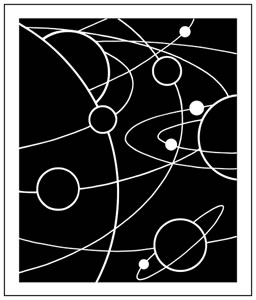4.6 Billion Years Ago
 AS WE SAW AT THE LAST STATION , the first generation stars eventually imploded, and scattered bits of themselves into space in a cloud of dust. As these clouds of debris slowed down and cooled, gravity once again sucked them into lumps. Where these masses became large enough, they ignited into second-generation stars such as our own, which formed around 4.6 billion years ago.
AS WE SAW AT THE LAST STATION , the first generation stars eventually imploded, and scattered bits of themselves into space in a cloud of dust. As these clouds of debris slowed down and cooled, gravity once again sucked them into lumps. Where these masses became large enough, they ignited into second-generation stars such as our own, which formed around 4.6 billion years ago.
As the sun formed at the centre of our solar system, it was surrounded by a spinning disc of dust and gas. These small particles crashed into each other to form larger lumps, eventually forming the planets, including the earth. The energy of all the bits crashing into each other was so great that the surface of the earth was molten for hundreds of millions of years. After 300 million years, the earth would finally cool enough for the surface to solidify, and rain to fall. That will be the subject of the next station.
The momentum of all the material sucked towards the centre of the gravitational field of the new sun, caused it to spin. Around the sun a disc of gas and dust formed that was spinning so fast that centrifugal force kept it from falling in. This ‘accretion disc’ was chaotic, with particles crashing into each other at thousands of kilometres per hour. Particles in the disc accreted into larger lumps, attracting more particles by gravity and ultimately forming the planets. Not all of the material has been incorporated into planets, but continues to spin around the sun as asteroids and comets, or tiny meteors that appear in the night sky as falling stars when they enter the earth’s atmosphere.
The moon is thought to have formed from the debris thrown into space when a massive planetoid crashed into the earth, increasing its mass by about 10%. The crumpling and weathering of the earth’s surface means that few of the craters formed by meteor impacts are still clearly visible. On the surface of the moon however, these craters remain obvious. This is because the moon has no atmosphere and is too cold to be geologically active.